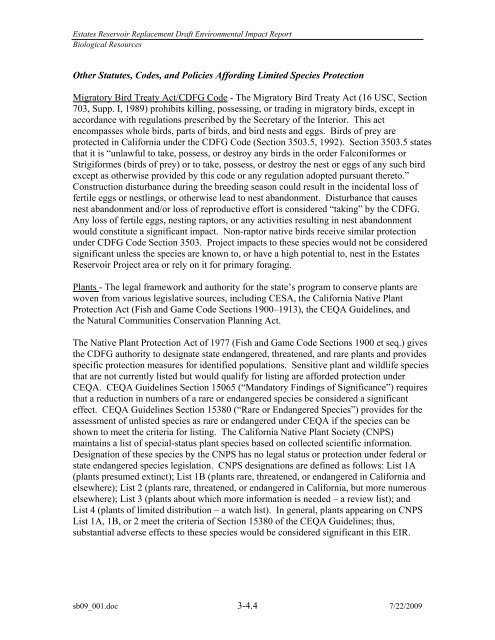Draft Environmental Impact Report - East Bay Municipal Utility District
Draft Environmental Impact Report - East Bay Municipal Utility District
Draft Environmental Impact Report - East Bay Municipal Utility District
- No tags were found...
You also want an ePaper? Increase the reach of your titles
YUMPU automatically turns print PDFs into web optimized ePapers that Google loves.
Estates Reservoir Replacement <strong>Draft</strong> <strong>Environmental</strong> <strong>Impact</strong> <strong>Report</strong>Biological ResourcesOther Statutes, Codes, and Policies Affording Limited Species ProtectionMigratory Bird Treaty Act/CDFG Code - The Migratory Bird Treaty Act (16 USC, Section703, Supp. I, 1989) prohibits killing, possessing, or trading in migratory birds, except inaccordance with regulations prescribed by the Secretary of the Interior. This actencompasses whole birds, parts of birds, and bird nests and eggs. Birds of prey areprotected in California under the CDFG Code (Section 3503.5, 1992). Section 3503.5 statesthat it is “unlawful to take, possess, or destroy any birds in the order Falconiformes orStrigiformes (birds of prey) or to take, possess, or destroy the nest or eggs of any such birdexcept as otherwise provided by this code or any regulation adopted pursuant thereto.”Construction disturbance during the breeding season could result in the incidental loss offertile eggs or nestlings, or otherwise lead to nest abandonment. Disturbance that causesnest abandonment and/or loss of reproductive effort is considered “taking” by the CDFG.Any loss of fertile eggs, nesting raptors, or any activities resulting in nest abandonmentwould constitute a significant impact. Non-raptor native birds receive similar protectionunder CDFG Code Section 3503. Project impacts to these species would not be consideredsignificant unless the species are known to, or have a high potential to, nest in the EstatesReservoir Project area or rely on it for primary foraging.Plants - The legal framework and authority for the state’s program to conserve plants arewoven from various legislative sources, including CESA, the California Native PlantProtection Act (Fish and Game Code Sections 1900–1913), the CEQA Guidelines, andthe Natural Communities Conservation Planning Act.The Native Plant Protection Act of 1977 (Fish and Game Code Sections 1900 et seq.) givesthe CDFG authority to designate state endangered, threatened, and rare plants and providesspecific protection measures for identified populations. Sensitive plant and wildlife speciesthat are not currently listed but would qualify for listing are afforded protection underCEQA. CEQA Guidelines Section 15065 (“Mandatory Findings of Significance”) requiresthat a reduction in numbers of a rare or endangered species be considered a significanteffect. CEQA Guidelines Section 15380 (“Rare or Endangered Species”) provides for theassessment of unlisted species as rare or endangered under CEQA if the species can beshown to meet the criteria for listing. The California Native Plant Society (CNPS)maintains a list of special-status plant species based on collected scientific information.Designation of these species by the CNPS has no legal status or protection under federal orstate endangered species legislation. CNPS designations are defined as follows: List 1A(plants presumed extinct); List 1B (plants rare, threatened, or endangered in California andelsewhere); List 2 (plants rare, threatened, or endangered in California, but more numerouselsewhere); List 3 (plants about which more information is needed – a review list); andList 4 (plants of limited distribution – a watch list). In general, plants appearing on CNPSList 1A, 1B, or 2 meet the criteria of Section 15380 of the CEQA Guidelines; thus,substantial adverse effects to these species would be considered significant in this EIR.sb09_001.doc 3-4.4 7/22/2009
















